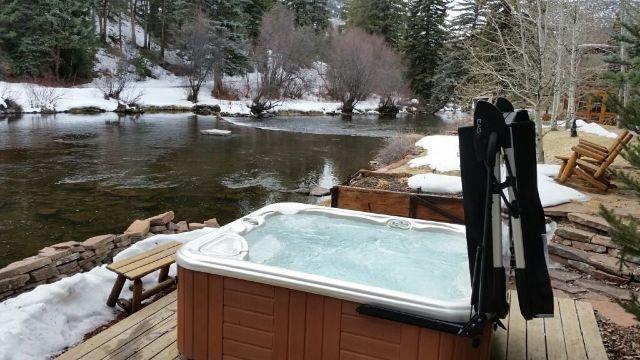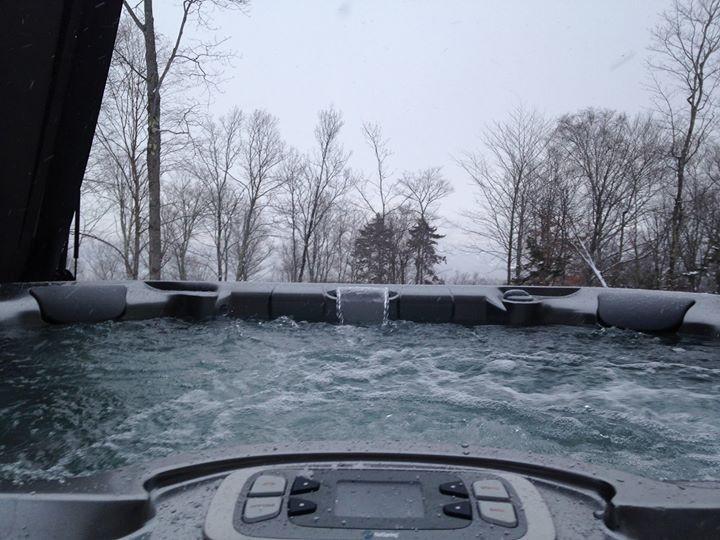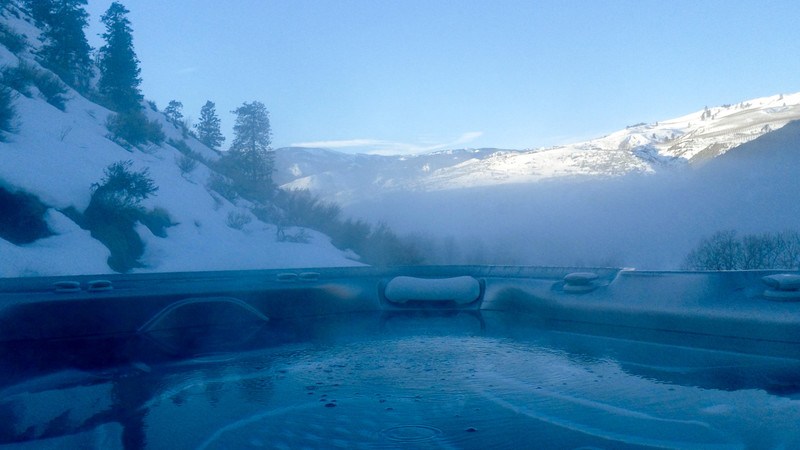
A hot tub can be a joy in every season. In the summer, it's a great place to relax under the stars as twilight falls, or to greet the morning as the world wakes up. In the winter, it's a perfect remedy for the drizzly, icy, sleety blues. Soaking in your spa at the end of a long, cold day while catching snowflakes on your tongue in your personal bubble of steamy bliss may be the all-time greatest way to spend a winter evening. Of course, as a prospective shopper, you're not just thinking about how lovely soaking in your hot tub on a snowy day will be—you're thinking about how winter's chilly temperatures might affect the cost of running your spa.
The electricity your spa's heater uses to keep your water hot is an ongoing expense associated with hot tub ownership. This cost would rises in the winter when the cold outside air forces your heater to work harder to maintain your water's constant high temperature. However, hot tub designers and engineers have taken important steps to minimize an operations cost impact. While cheaply-designed, low-end hot tubs don't have the necessary features to keep out the cold without causing a big spike in your electric bill, hot tubs built for quality will be able to stand up to the harshest winters with a minimal increase in your energy costs. While the total price of running a hot tub depends on a variety of factors, the best hot tubs may cost as little as $10 to $20 per month to operate. Here are some of the factors that will affect how much your hot tub costs to run in winter:

YOUR HOT TUB'S INSULATING BASE PAN
As anyone who's spent time camping knows, one of the easiest ways to lose heat is through direct contact with the ground. During the colder months, the ground can leach away large amounts of heat, whether from hot tubs or from campers in sleeping bags.
To prevent this heat loss, base pans are included in all high-quality spas. These base pans sit between the hot tub's bottom layer, which comes into direct contact with the ground, and the hot water you soak in. This extra thermal barrier prevents heat from escaping into the ground. Hot tubs with base pans are far more effective at preserving heat than those without them, and thus are less expensive to run in the winter.

YOUR HOT TUB'S QUALITY THERMAL INSULATION
The quality of your insulation makes a significant difference when it comes to the cost of running your hot tub. Hot tubs with either little insulation or low-quality insulation stand to lose much of their heat through the four sides of the spa, forcing the components to work harder to keep the water temperature consistently high. The end result? Higher energy costs. In order to keep all that heat inside your spa, high-quality hot tubs come with dense, energy-efficient full-foam insulation. The hollow areas in between the outer frame and inner shell are filled with thick foam that hardens inside the hot tub; the foam saturates the whole area, forming a layer that entirely fills that interior gap. Luxury and premium hot tub take full-foam insulation a step or two further, with innovations such as specially-engineered multi-density foam that can also provide additional structural support for your spa. By making sure your heat stays inside your spa, high-quality insulation will significantly reduce the amount of energy your heater must use to keep your water hot.

YOUR HOT TUB'S DURABLE, FITTED COVER
Human beings lose most of our heat through our heads—that's why we wear hats in the winter. In a similar vein, if hot tubs aren't securely covered when not in use, they lose a lot of heat. Whenever hot water makes direct contact with cold winter air, a rapid cooling process occurs. This puts significant stress on the heater as it strains to keep up, spiking the cost of running your hot tub.
To prevent this, high-quality hot tubs come with thick, durable, insulating covers. This barrier between hot water and cold air does a fantastic job of preventing heat loss. Your cover should create a tight, secure seal around the edges of your hot tub to keep heat from leaking out. They're built thick and heavy to prevent heat from escaping. Covers come into direct contact with the outside elements, including rain and snow, so they're designed to be durable and long-lasting. In inclement weather, a cover lifter is an absolute necessity for moving the cover on and off of your hot tub. These devices allow you to effortlessly protect your hot tub from the effects of cold weather.

YOUR WINTER HOT TUB ENERGY COSTS
A well-built, high-quality hot tub with a base pan, dense insulation, and a thick, fitted cover is surprisingly inexpensive to run—even in winter. While multiple factors including your location, utility company, climate, and the temperature at which you keep your spa running will determine the actual price, using this calculator will give you a general idea of what your energy costs might be. The extra care and attention paid to design and engineering that goes into the construction of a high-quality hot tub will pay dividends on your electric bill for the life of your spa.
Hot Spring Spas believes in quality. That's why we design our hot tubs to be the absolute best hot tub ownership experience. Hot tubs manufactured by Hot Spring are insulated either with multi-density full foam or with the proprietary FiberCor® insulation, a Watkins Wellness® exclusive. Our base pans reduce heat loss and protect sensitive components. Our high-quality, custom-fitted covers seal snugly and securely. Your local hot tub dealer will be able to tell you more about your hot tub's operating costs for your specific spa model and your local climate. To learn more about which of our hot tubs might be right for you and your family, download our brochure.